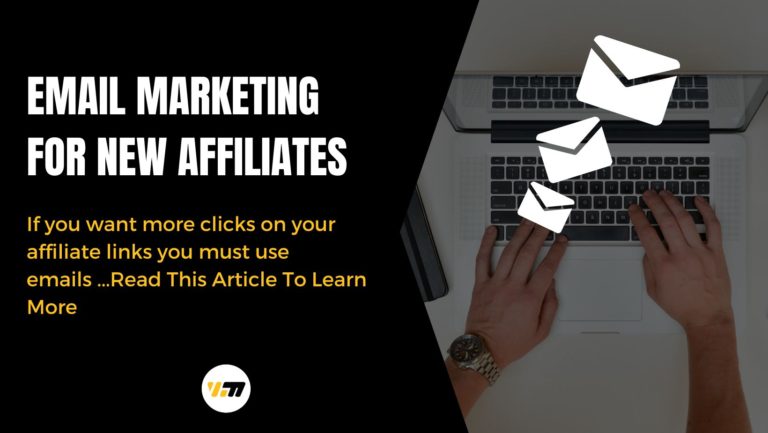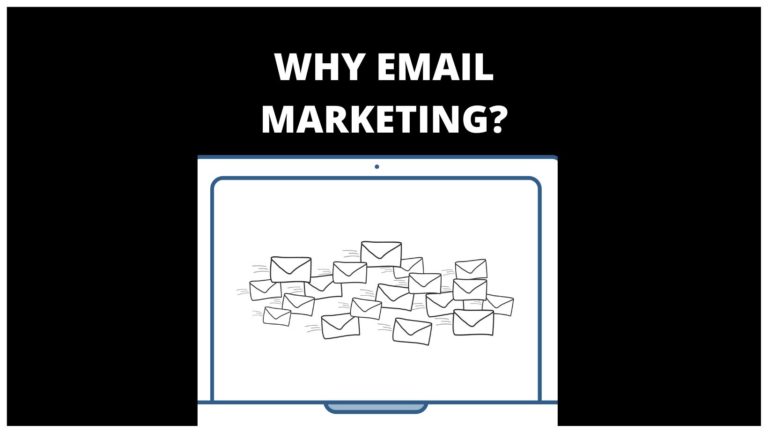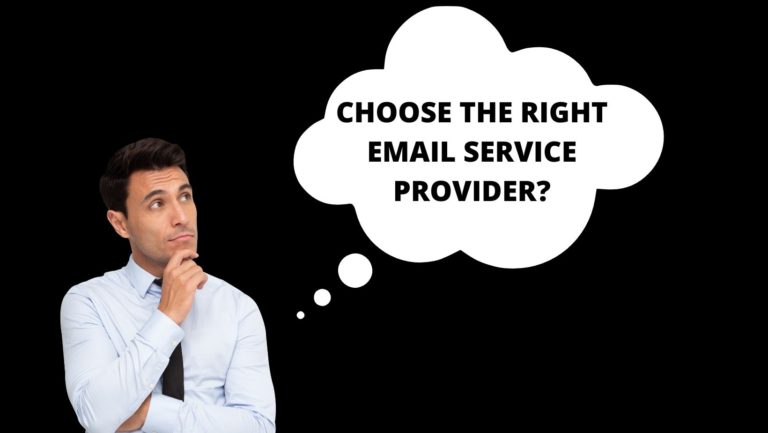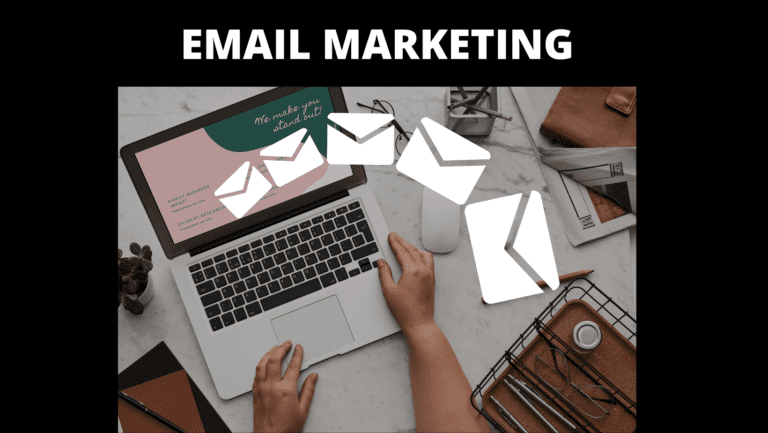email marketing for affiliates

If you are looking for a way to improve your affiliate marketing results you should consider using email marketing. Email marketing will help you approach your audience in a more personal way. It will also help you generate more leads and more sales. In this blog post, we’ll discuss the basics of email marketing for affiliate marketers.
Doing affiliate marketing without an email list means leaving money on the table. Many people fail to use email marketing and aren’t aware of its full potential. There are many different ways to use email marketing in order to increase sales and profits. Let’s find out tips on how to create effective email campaigns that will engage your email readers and get them motivated to take action.
What is Email Marketing?
Email marketing is a form of digital marketing where you collect emails of a specific group of people. Then send personalized emails to this audience to your landing page, website or your blog with the aim to increase your sales or promote a product or a service.
SOURCE GIPHY
Three Types of Marketers
There are three types of email marketers:
Legit marketers
Marketers collect emails legally, which means with the permission of the email owner. It can be done in many ways, the most common methods are opt-in forms on websites and landing pages.
Mass Marketers
Mass marketers scrape emails from the internet (without permission) and use them without the consent of email owners. So they send promotional emails that are considered spam.
Cold Mail Marketers
Cold mail marketers are legit marketers. They send emails to people who haven’t subscribed to their email list. The difference between mass marketers and cold marketers, however, is that cold marketers offer value through emails. Cold mailers avoid any sales or promotional content in the first emails they send.


Why Use Email Marketing For Affiliate Leads and Sales?
Getting started with email marketing can be difficult, but you’ll quickly see the benefits when you start reaping the rewards. Here’s how email marketing can make a difference to your affiliate business:
Full Control
When you build an audience on YouTube, social media or ecommerce platforms like: Amazon, Etsy and so on, you don’t have control over that audience. Your account on those platforms can be closed anytime for a reason or another. But, once you build an email list it is yours.
Increase Revenue
One of the biggest reasons why more affiliates are choosing to use email marketing is that it’s an effective way to increase revenue. When you use email marketing, you’re able to reach a large number of people that have already shown interest in your affiliate products or services. This means that it’s likely that many of the contacts on your list are pre-qualified buyers that are ready to open your emails and click through to buy what you’re selling or promoting.
Increased Loyalty
Email marketing is also a great tool for increasing loyalty among existing customers. If people enjoy receiving emails from you about new offers, discounts, tips, advice, etc. Then they’ll be more likely to become repeat purchasers of your products or services in the future.
All you need to do is send them regular emails about related topics of value, so they don’t get sick of being bombarded by promotional emails. Growing your email list can help you to grow your list of contacts faster than other methods such as social media or search engines. This is because it’s an effective way to build trust and credibility with potential customers.
Precision
You market to people who are interested in what you have to say. In email marketing, unlike other forms of marketing, you are targeting an audience that subscribed to your list willingly. In most cases, they are interested in what you have to say.
Automation
You can automate emails using an email marketing provider. Create, customize and schedule a series of emails to be sent at specific dates you specify. There are plenty of providers to choose from. You can check this article that compares Sendinblue to Getresponse.
Low Cost
Email marketing is cost-effective compared to other methods. It gives back an average of $36 for every $1 you spend. You get 36 times as much if you put in ONE dollar.


How to Choose the Best Email Marketing Service?
You may be surprised to know that it is possible to do email marketing without any email software provider.
Yes, you heard it right!
You don’t need any service. But, to set up your signing forms, create the templates, audience segmentation, and send the emails manually is time-consuming. Plus, some email marketing aspects are hard to manage without software, for example, email bounce and spam.
So, it makes sense to use one of the email services that offer valuable tools and services to help you launch your email campaigns in minutes. Automate your campaigns and manage them like an expert.
There are tons of email service providers on the market today. It can become overwhelming when it comes to choosing a service provider. To choose the right software for your business, you need to determine some things, like:
What is your target audience?
What is your email marketing goal?
What is the size of your list?
What type of campaigns are you planning to run?
Check our blog for the different email service providers’ reviews and comparisons. For example: Sendinblue vs Getresponse.
How to Create An Effective Email Campaign
As a marketer, you give people something in exchange to capture their emails. It has to be free and of great value so people subscribe to your email list and allow you to email them. The free gift is called a lead magnet.
Lead Magnets
A lead magnet can be an e-book, a checklist, a free tool, an audio file, or any other form.
In this video, I talked about important criteria for a premium lead magnet and some different ideas of what to offer as a gift.
A lead magnet should be:
Easy to create, packed with value, and easy to consume and gets your Audience into Action.
Some marketers give the advice to offer pre-made lead magnets that are free and you have the right to distribute. They are called PLR sites. You can go to a website like: idplr.com and then you choose what you would like to download and use as a lead magnet.
But I advise you to edit them and do your own style, and brand if the licensing allows you to. As they are free you can imagine how many marketers already used them. You edit them yourself on Canva or pay a freelancer to do it for you.
Optin Forms
Optin forms are the medium that allows you to send your lead magnet to your audience. Optin form is a piece HTML that allows your visitors to enter their emails.
I advise you to add some form of an opt-in form on the pages with the highest traffic. This way you increase your chances to get more leads and grow your email list.
Now, when it comes to designing the opt-in form you should consider:
Attention Grabbing Headline
You want your visitors to subscribe to your newsletter by reading the headline. It has to communicate the benefit of the lead magnet they are going to get.
Concise Description
The description has to be short and straight to the point. Write in the form of either short paragraphs or sentences.
Optin Form Design
Choose attractive images that represent your lead magnet. I usually use mock-ups of eBooks or checklists,…etc. Plus, you can add a picture of a friendly person on the form to increase the conversions. Use colors of the brand if whenever possible and add a nicely designed button for the subscription.
The Different Types of Emails
Now that we’ve briefly discussed the benefits of using email marketing, we’ll now discuss six types of emails you can send out to increase both sales and profits:
Welcome Emails
You should send a welcome email after someone subscribes to your list. In this email, you’ll need to quickly introduce yourself and provide a link to one or more affiliate products that you recommend. It should only take around 60–90 seconds to read this email, so keep it light and interesting.
Tip: Include a link to your best selling product at the end of the email to encourage new subscribers to buy straight away.
Thank You Emails
The purpose of a thank you email is to say ‘thank you’ for taking the time to subscribe. This will remind readers why they joined your list in the first place, while also encouraging them to stay on the list and continue getting future emails from you.
Always offer one or two free gifts or discounts in this email. If possible, tie these items into what’s being discussed in this particular blog post/email series sent out by you. These are just a couple of examples, so feel free to add your own ideas to this kind of email.
Start Building Trust and Credibility
Now that you’ve thanked your readers for subscribing and sent them a few recommendations along with some discounts. It’s time to start building trust and credibility by providing specific tips and advice on how they can make the most out of what you’re offering. This is important because you’ll need to prove to your subscribers that you really do know what you’re talking about before selling any affiliate products/services.
Tip: For example, if it’s an e-book or video training course about making money online, then provide detailed instructions on where prospects can get started (e.g., blog hosting + domain name etc.). You could also do this by involving them in a short case study (e.g., if you run an internet marketing blog, then write about how someone managed to make money using your advice).


New Product Emails
A new product email is sent out when you launch a new product or service. It’s important that you offer your subscribers early access to ‘bargain’ prices and discounts before it goes live and is offered at the regular price. The purpose of this email is to help you build relationships with customers and increase trust/credibility so they’ll buy from you when they’re ready.
Note: Be sure not to mention any affiliate links when offering “early bird” deals or discounts, as these types of emails are meant for building trust and credibility only.
Product Launch Emails
Before you launch a new product or service you should send a product launch email, and it’s the last email you’ll ever need to send if done correctly.
You can let your readers know about an upcoming product launch and provide them with exclusive offers and discounts so they feel special and valued.
Make sure you clearly highlight the benefits of buying from you rather than going elsewhere for this particular product/service (e.g., greater value for money). The purpose of sending these types of emails is to reward those who were loyal customers (and believed in your business) since day one; as well as to provide others the opportunity to ‘test drive’ what you have to offer at a bargain price.
Common Mistakes by Marketers
“Harsh but True:” One of the biggest mistakes beginners make when using email marketing for affiliate marketing is to send promotional emails all the time without providing any value whatsoever.
Promotional emails will only serve to annoy readers and drive them away from your website. This harms your reputation and your sales/profits in the long run.
For these reasons, it’s important that you send helpful tips/advice along with occasional recommendations about relevant products or services.
The strategy will help you establish yourself as an expert in your field and attract customers from all over who are looking for solutions from someone reputable.
In short: Email marketing should be used as a tool to provide relevant information and solutions to your readers. The more you do this, the more trust and credibility you’ll build in their eyes, and the greater sales/profits you’ll see in return.


Final Thoughts!
The best way to get started with email marketing for affiliate marketing is by understanding the different types of emails you can send out.
Sales emails are a great place to start because they’re focused on increasing sales and getting customers to buy your products.
Autoresponders help nurture leads through the customer lifecycle so that you don’t have to worry about managing those interactions yourself at scale.
Newsletter campaigns work well as long as you’re sending content people actually want. It’s not just promotional material all the time!
Depending on what kind of subscriber list or audience you’re building, there may be other kinds of emails worth experimenting with too like welcome messages, follow-ups after purchase, or lead generation events.


